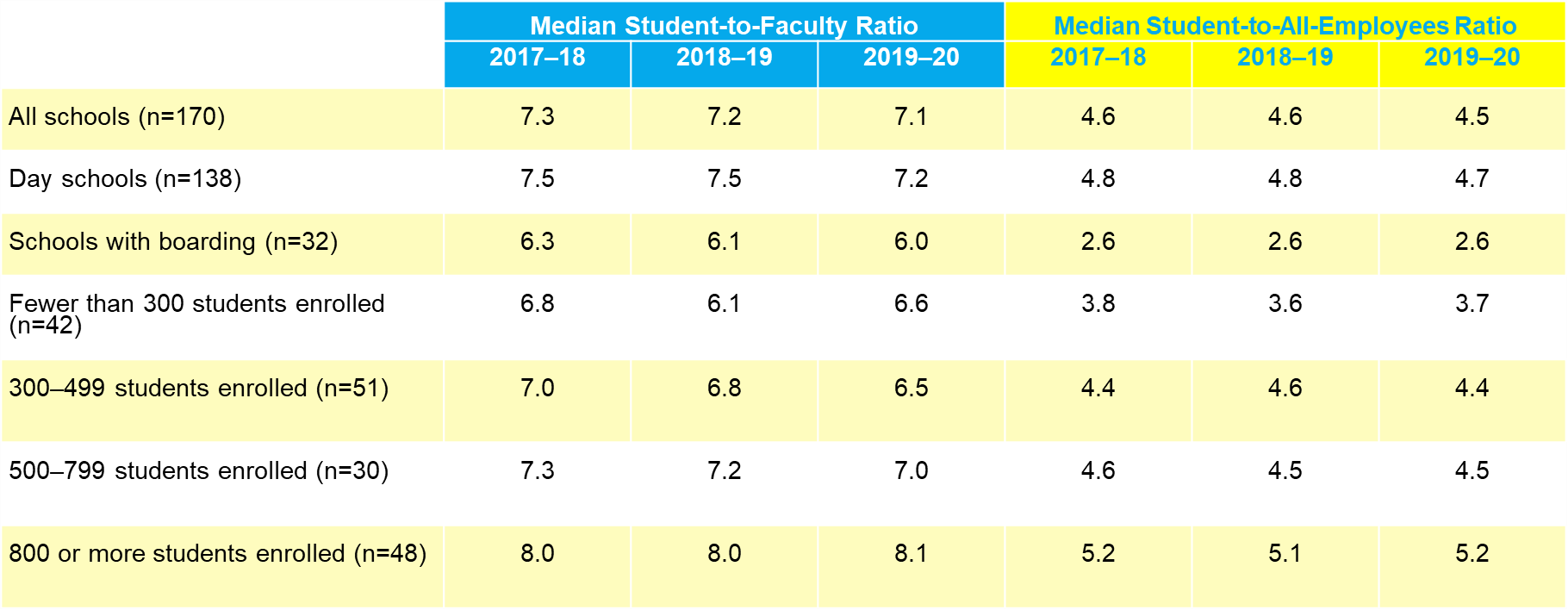Article by Elizabeth Dabney, NBOA
Independent schools frequently tout their low student-to-faculty ratios as part of their value proposition because these ratios are often considered a marker of a high-quality education. To determine the cost and efficiency of delivering a school’s program, however, schools should be monitoring both student-to-faculty and student-to-all-employees ratios.
BIIS data from 2018-2020 shows both ratios trending downward in independent schools, suggesting that schools are increasing staffing without a corresponding rise in student enrollment. At some schools, new academic positions are not necessarily classroom teachers but rather staff providing learning support, like tutors or managers of new instructional programs. We know that salaries and benefits are a school’s biggest expense, so an increase in personnel costs without an increase in tuition revenue could put a school in an unsustainable financial position.
What trends does the data reveal?
- While enrollment declined, staffing increased. Student enrollment across the 170 schools decreased from a median of 475 students in 2017–18 to 463 students in 2019-20, with 51% of these schools experiencing a decline or no change in enrollment. Instructional support full-time equivalents (FTEs) increased 3% over these years, and total FTE employees increased 1%.
- Student-to-staff ratios decreased. The median student-to-faculty ratio decreased from 7.3 in 2017–18 to 7.1 in 2019-20. The student-to-faculty ratio decreased at 58% of schools, remained the same at 6%, and increased at 36%. The median student-to-all-employees ratio decreased from 4.6 to 4.5. The student-to-all-employees ratio decreased at 52% of schools, remained the same at 12%, and increased at 36%. Among the subset of schools that experienced a decline or no change in enrollment, the median student-to-faculty ratio decreased from 7.3 to 6.8.
- Payroll expenses increased. Instructional payroll and benefits expenses increased 9.5% between 2017–18 and 2019–20. Total payroll and benefits expenses for all school employees increased 8%. The schools with declining or stable enrollment saw increases in instructional payroll and benefits and total payroll and benefits of 8% and 4%, respectively.
“These numbers indicate a shift in the student population — today’s students need more support in their classrooms."
—Amber Stockham
NBOA
These patterns were similar at day schools and schools with a boarding component. At day schools, the median student-to-faculty ratio declined from 7.5 in 2017–18 to 7.2 in 2019–20, and at schools with boarding this ratio declined from 6.3 to 6.0. FTEs increased at both types of schools, and total payroll and benefits expenses increased 8.2% at day schools and 7.2% at schools with boarding.
The largest schools, those with 800 or more students enrolled, bucked the trend and saw an increase in the student-to-faculty ratio, from 8.0 in 2017-18 to 8.1 in 2019-20, with the students-to-all employees ratio holding steady. Unlike at smaller schools, which experienced declines in enrollment, enrollment at the largest schools increased 1.3%. The largest schools increased instructional and instructional support FTEs by 4.3% over these years, with an increase in instructional payroll and benefits expenses of 15.2%. Just over half of these schools (53%) covered the increased instructional payroll and benefits expenses with increased net tuition revenue. These schools generally can flex staff levels as needed to deliver their programs. They are more likely to have built in staffing redundancies and can redistribute faculty to meet students’ changing academic needs.
“These numbers indicate a shift in the student population — today’s students need more support in their classrooms,” said Amber Stockham, NBOA’s director, human resources programs. “That appears to be resulting in an increase in academic staffing without an offset through increased enrollment or decline in other types of staff.” Schools will have trouble sustaining the staffing increases in the long term without changes in other areas, she pointed out.
Stockham suggested the following as ways to meet needs while balancing the budget:
- Make cuts in other areas of school operations.
- Cross-train underutilized employees to assist in the classroom, providing both job stability and needed support.
- Re-envision the staffing structure and school schedule to make time for academic support activities like writing centers and tutoring labs.
What will work at one school may not work at another, Stockham said. Regardless, “schools will need to shift how their faculty and staff are deployed to meet student needs without weighing down their salary budget. Making that transition will require creativity and vision.”




